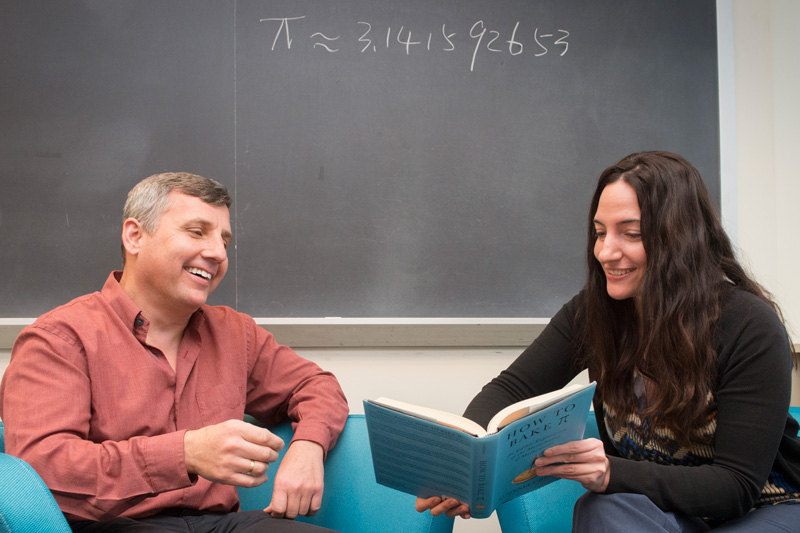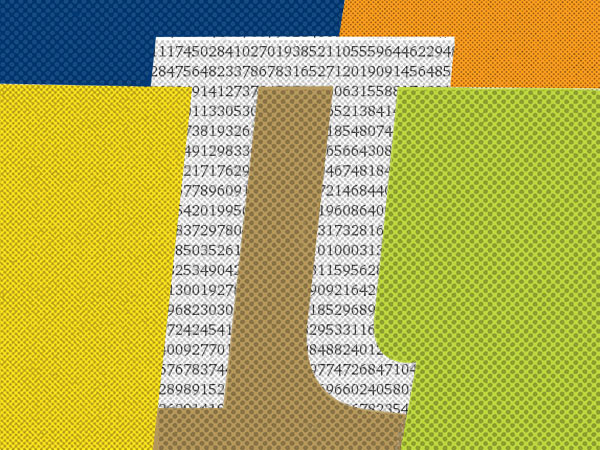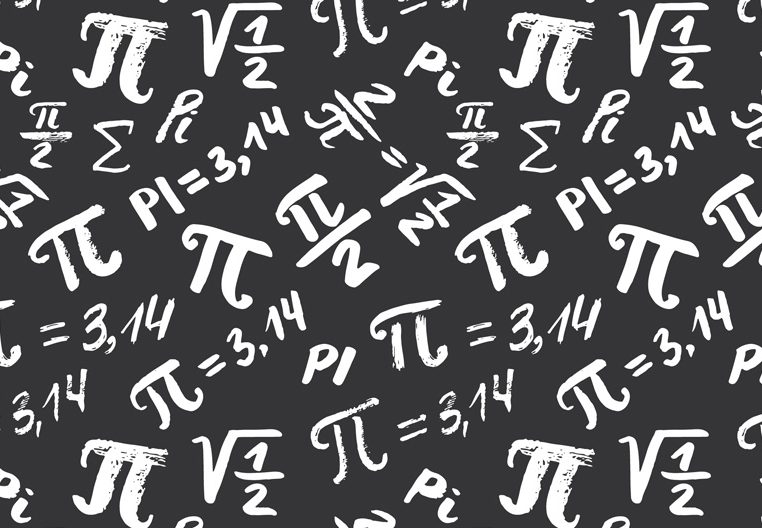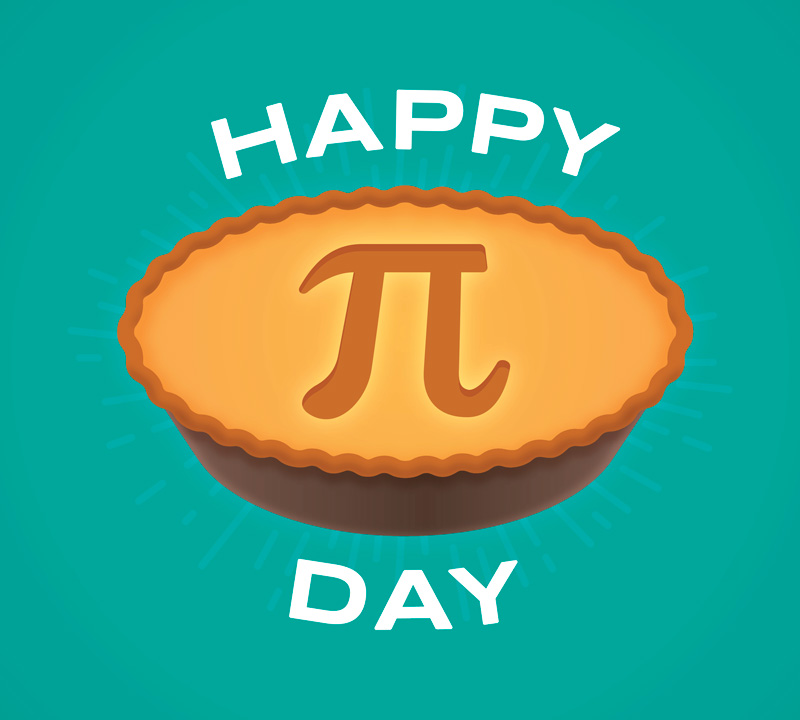


Pi Day: UD math professors explain
Photo by Wenbo Fan | Graphics by Jeffrey Chase and iStock March 14, 2019
UD Math Department Chair Louis Rossi and Assistant Professor Eirini Kilikian share insights
Editor's Note: To honor math and all who use it, UDaily is re-posting a Pi Day story from 2018.
March 14 is Pi Day. You’re welcome to eat pie, too, but the day is more of a celebration of math.
A concept most of us learn during our early school days, pi is the ratio between the circumference of a circle and its diameter. No matter what size the circle, this ratio always remains the same.
The earliest known uses of pi date back to 2550 BC. Yet, Greek mathematician Archimedes is credited as the first person to calculate an accurate estimation of pi’s value, sometime around 250 BC.
The symbol for pi, written as π, comes from the Greek alphabet. The first few digits of pi’s numerical value are 3.14, hence the celebration date of March 14. Pi Day was started in 1988 by Larry Shaw, a physicist who worked at a San Francisco museum.
In honor of pi day, UDaily sat down with the University of Delaware’s Math Department Chair Louis Rossi and Assistant Professor Eirini Kilikian to talk about pi, math, and the importance of this informal holiday.
Can you start by sharing a bit about yourselves and what brought you to UD?
Kilikian: I’m newer than Lou at UD. I started in August and in my life before UD, I’ve always studied applied mathematics. So that was my bachelor’s degree, master’s and Ph.D. When I graduated last May, I was accepted to start working here in mathematical science. I’m enjoying teaching so far, so I can’t complain.
Rossi: I’ve been here a while. I’m a professor of mathematics and the chairman of the department. I like teaching, I like doing research and I like advancing mathematics on campus. That’s very important to me, so whether students need a little bit or a lot, I try to make sure they enjoy doing mathematics and they see mathematics in the world around them.

Can you explain the basics of pi and why it is relevant in math?
Kilikan: As a mathematician you see pi everywhere. It is in number theory, waves, anything circular of course. So I see pi all the time. What is so special about it? It’s just a symbol to us, but it is not actually that symbol. So, I thought of my first encounter with pi, which of course was back when I was a little girl in school, but it took a while to appreciate the vastness in it. The reality hit me when I was in college. No matter how many digits of pi you find there will always be more. So I ended up realizing that means we cannot actually define it. We will never ever be able to fully know what pi is.
Rossi: There is a result that allows you to calculate any digit of pi in binary. If you say, ‘Just tell me the one billionth decimal of pi,’ no one knows how to do that. You have to calculate a billion digits, but in binary that’s a decimal. When I was a kid I remember there would be an announcement almost every year that someone did another calculation of pi. What the use of that was, I don’t know.
Kilikian: I think this sort of quest, the holy grail of finding one more digit of pi is far beyond its practical use. So it’s just curiosity. What will the next one be and how will we find it? I don’t know how far we will ever get.
Rossi: It is amazing when you think about it. If you take the ratio between the diameter of a circle that is a pure number and it’s pi. It is the fundamental non-integer ratio out there. It just turns up in everything.

Most people solely see pi as a math concept, but are there practical uses for it outside of standard math?
Rossi: I’ll give you an example. While I was a graduate student I also ran a pizza restaurant. My parents and I were setting up the menu, and one of the things we noticed about the data from other restaurants is medium pizzas never sell very well. My father asked me, ‘Is it price?’ It never occurred to him to calculate the area of each one. Now there’s a little more to it than that, but we sat down and did all this really quick using pi.
So what’s the conclusion?
Rossi: It’s overpriced. Did people calculate and make a decision? No, but I think they just experienced it. You experience it enough times that you’re like, ‘Oh I’ll just get the large and get a lot more pizza.’ Even though people don’t reason explicitly in math, cognitively people reason statistically.
Given pi’s relevance and fundamental place in society, why do you think it’s important that pi day is a (sort of, unofficial) holiday?
Kilikian: I have to confess that I didn’t know this was a holiday until I moved to the U.S. I think the good part of having a holiday like this is just having a recognition of how important this number is in mathematics. It might be a good starting point for new people who want to be interested in science, even study why mathematicians like this number so much. It is important to get kids interested in mathematics or STEM in general. And that will open a door to finding the importance of this and finding a segue to actually opening other doors after.
Rossi: Pi day is more than celebrating a number. Pi day is a celebration of mathematics. It's the fundamental abstraction of reality when you think about it and that’s really important. Like Eirini said, it’s about contemplating the infinite.
Do you come across pi in your own research or teaching?
Kilikian: Well, teaching of course. It comes up in calculus classes a lot. I haven’t taught too many classes, but in the range of classes I have taught, pi was always there. In my research it is related to some probability and distributions.
Are there problems you are not currently looking at, but would like to eventually research?
Kilikian: I like baking and I was wondering how I could combine this with my math interests. I know there is this thing called cooking mathematics where people study the fusion of heat in foods. I haven’t got into this ever, but it is something I would like to at least be informed about.
Rossi: Well, it’s a little bit complicated. You know snowflakes all look different, there’s a very good mathematical reason for that. I think there’s a simple way to express the mathematics and explain the structures we see. I would just like to understand that a lot more deeply. I think there is something universal in there and I’d like to get a grip on that in my free time.
Do you have advice for high school students on how they can prepare for college level math?
Rossi: I would just say that any decision you make is more powerful if it has mathematics behind it. Curriculum kind of tends to lead you down certain routes, but I like to think mathematics is broad. We went really deep in the ‘60s of the space race — all calculus and differential equations. There’s all kinds of wonderful things. So, I’d say it's exciting. There’s a lot of mathematics to pick and choose from and it gives you insight and power over making these critical decisions.
Kilikian: What I would add is, people coming into college shouldn’t be afraid to challenge themselves. Whenever you go to learn something new it will be challenging, it will be hard for you. So give it a chance and mathematics can be very rewarding.
Do either of you get strange questions from family members about what exactly you do as a mathematician?
Kilikian: I can go in tangents and talk a lot so at some point family members will stop me and say, ‘Oh okay, what other news?’ They don’t care about the deep math of what I’m doing. What happens even more is I explain math to my husband even if he doesn’t ask. The poor guy has to hear about ideas. It is very interesting and funny because he understands maybe less than half, but he looks excited because I’m excited.

Rossi: Well, I’ll tell you a story. I have an uncle who worked for the railroads. He’s very skeptical of people with college degrees. So after I finished my math degrees I visited. So he walked up to me and he said, ‘You’re a mathematician huh? Tell me which numbers to pick for the pick six lottery.’ I said, ‘Well, Uncle Stach, it’s random.’ He says, ‘Yeah well, but certainly some might turn out more than others?’ I said, ‘Yeah, well if I were you I wouldn’t bet on the lottery, but if I were to bet on the lottery, I would pick a sequence like 6-5-4-3-2-1 because no one else will do that. They pick birthdays and other stuff. So then if you win, you have the same chance, but no one else will pick it so you won’t have to split the winning.’
Kilikian: Please tell me that he won the lottery.
Rossi: No, he didn’t win and he thought my idea was stupid because 6-5-4-3-2-1 would never come up in the lottery.
It could!
Rossi: Absolutely, exactly the same chance as any other combination. So we had a long conversation about that.
Kilikian: Did you convince him by the end?
Rossi: Yeah, I think I had him. But I’m sure he didn’t win anyway, so he’s like, ‘Ah, that idiot nephew.’
So playing off the idea of pies on pi day, what are your favorites?
Kilikian: I like all pies. It is very hard for me to choose. I would definitely pick a savory pie, not a sweet pie. Either spinach pie or leek pie or cheese pie.
Rossi: I’d say either lemon meringue or apple. Half and half would be good.
This interview has been edited for length and clarity.
Contact Us
Have a UDaily story idea?
Contact us at ocm@udel.edu
Members of the press
Contact us at 302-831-NEWS or visit the Media Relations website

